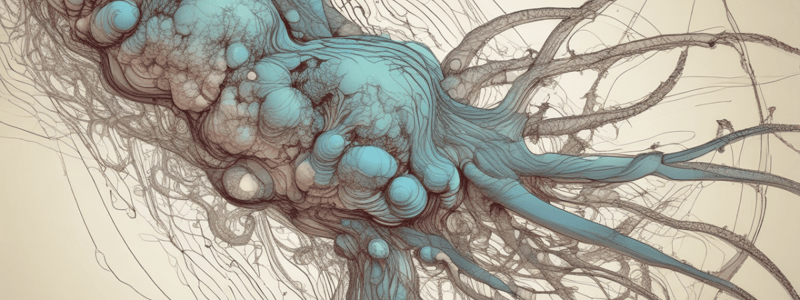Podcast
Questions and Answers
What is the primary function of sensory receptor cells?
What is the primary function of sensory receptor cells?
- To regulate hormone production
- To communicate with neurons
- To respond to physical or chemical stimuli (correct)
- To synthesize neurotransmitters
What type of receptor is responsible for our sense of touch?
What type of receptor is responsible for our sense of touch?
- Electromagnetic receptor
- Mechanoreceptor (correct)
- Chemosensor
- Photoreceptor
Where are the membrane receptors embedded in the case of smell?
Where are the membrane receptors embedded in the case of smell?
- In the synapse between sensory neurons
- In the plasma membrane of glial cells
- In the sensory neuron membranes (correct)
- In the cell membrane of receptor cells
What is the initial step in sensory transduction?
What is the initial step in sensory transduction?
What is the function of Merkel's disks?
What is the function of Merkel's disks?
In which part of the nasal passage are the chemosensitive projections of neurons located?
In which part of the nasal passage are the chemosensitive projections of neurons located?
What type of stimulation do Pacinian corpuscles detect?
What type of stimulation do Pacinian corpuscles detect?
What is the function of hair cells in the vestibular system?
What is the function of hair cells in the vestibular system?
What is the light-sensitive protein that converts light energy into electrical signals in photoreceptors?
What is the light-sensitive protein that converts light energy into electrical signals in photoreceptors?
What type of mechanoreceptors detect sense of hearing and balance?
What type of mechanoreceptors detect sense of hearing and balance?
What is the function of the middle ear bones?
What is the function of the middle ear bones?
What is the characteristic of compound eyes?
What is the characteristic of compound eyes?
Which type of mechanoreceptor responds to low-frequency vibration?
Which type of mechanoreceptor responds to low-frequency vibration?
What is the function of the oval window in the cochlea?
What is the function of the oval window in the cochlea?
How do hair cells convert mechanical vibration into nerve impulses?
How do hair cells convert mechanical vibration into nerve impulses?
What is the function of the semicircular canals in the inner ear?
What is the function of the semicircular canals in the inner ear?
What is the role of retinal in the process of visual transduction?
What is the role of retinal in the process of visual transduction?
Study Notes
Sensory Systems
- Sensory systems include taste and smell (chemosensory systems), touch, hearing, and balance (mechanoreceptor systems), and sight (electromagnetic receptor systems).
Sensory Receptor Cells
- Rely on membrane receptors embedded in cells that communicate with neurons (taste and sight) or directly in neuron membranes (smell).
- In most multicellular animals, receptor cells are organized into sensory organs.
Sensory Transduction
- Conversion of physical or chemical stimuli into nerve impulse occurs at the sensory receptor.
- Stimulated membrane sensory receptor causes ion channels in the plasma membrane to open.
- Sensory receptors either fire action potentials themselves or synapse with neurons that do.
- Signals are interpreted in the CNS (Perception).
Chemoreceptors
- Provide the sense of smell and taste.
- Respond to molecules in the environment (or our mouth) that bind to receptors in the cell membrane.
- Smell: chemosensitive projections of neurons extend into the mucus that lines the upper part of our nasal passage.
- Taste: taste buds on our tongue are specialized cells that synapse with sensory neurons.
Mechanoreceptors
- Respond to physical deformation of the plasma membrane.
- Open a Na+ ion channel, causing an action potential to fire.
- Responsible for our sense of touch.
- Types of mechanoreceptors:
- Merkel's disks respond to light touch.
- Meissner's corpuscles respond to touch and low-frequency vibration.
- Ruffini endings detect stretch, deformation within joints, and warmth.
- Pacinian corpuscles detect transient pressure and high-frequency vibration.
Hearing and Balance
- Hair cells are specialized mechanoreceptors that sense mechanical vibration using stereocilia on their surface.
- Do not fire action potentials, but synapse with neurons.
- Stimulation of hair cells alters the rate at which neurons fire.
- Hair cells responsible for hearing are contained in the cochlea.
- Sound vibrations enter outer ear, vibrate the tympanic membrane, and then move the bones in the middle ear (incus, malleus, and stapes).
- Middle ear bones then vibrate the oval window in the cochlea.
Balance
- Hair cells sense balance relative to body orientation to the environment.
- Vestibular system in the inner ear detects gravity, acceleration, and deceleration using 3 semicircular canals.
- Each semicircular canal detects angular momentum in one plane that the head can turn (nodding up-down, turning left or right, or moving side to side).
- When the body moves, fluid in the canals moves hair cells, and the hair cell movement is converted into nerve impulses.
Electromagnetic Receptors
- Respond to electrical, magnetic, and light stimuli.
- Photoreceptors are the most common.
- Opsin: light-sensitive protein that converts light energy into electrical signals.
- Each opsin protein contains a pigment called Retinal.
- When light energy strikes Retinal, it shifts from a cis to trans-isomer configuration.
- This shift in configuration opens Na+ channels to depolarize the cell.
- Animal eye configuration and anatomy vary widely.
- Types of eyes:
- Eyecups: detect light intensity and direction.
- Compound Eyes: each lens is called an ommatidium.
- Single-lens Eyes.
Studying That Suits You
Use AI to generate personalized quizzes and flashcards to suit your learning preferences.




